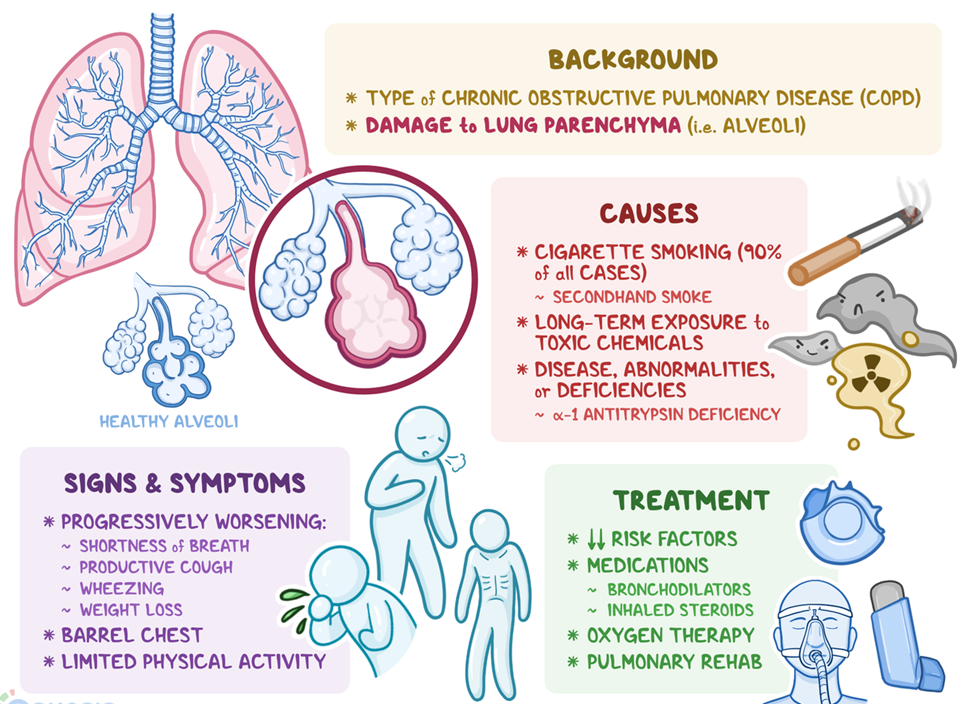A nurse is collecting data from a client who has emphysema. Which of the following findings should the nurse expect? (Select all that apply.)
Dyspnea
Barrel chest
Clubbing of the fingers
Shallow respirations
Bradycardia
Correct Answer : A,B,D
A. Dyspnea: Dyspnea is a hallmark symptom of emphysema. As lung function deteriorates, the client experiences difficulty breathing, especially during exertion, due to reduced gas exchange and air trapping in the lungs.
B. Barrel chest: A barrel chest is a common finding in emphysema due to hyperinflation of the lungs over time. This causes the chest to become rounded and expands the anterior-posterior diameter of the thorax.
C. Clubbing of the fingers: Clubbing of the fingers is not a typical finding in emphysema or COPD. It is more commonly associated with conditions like lung cancer, cystic fibrosis, or congenital heart disease, where chronic severe hypoxia is present.
D. Shallow respirations: Clients with emphysema often exhibit shallow respirations as their lung elasticity decreases, making it difficult to fully exhale. As a result, breathing may become more rapid and shallow to compensate for poor oxygen exchange.
E. Bradycardia: Bradycardia is not typically associated with emphysema. Instead, clients with chronic respiratory conditions like emphysema may experience tachycardia as the body tries to compensate for low oxygen levels.

Nursing Test Bank
Naxlex Comprehensive Predictor Exams
Related Questions
Correct Answer is A
Explanation
A. Lower oxygen saturations of 93% to 94%
In an older adult client with a pneumothorax, the nurse could expect to observe lower oxygen saturations of 93% to 94%. A pneumothorax involves the accumulation of air in the pleural space, which can compress the lung and impair gas exchange, leading to hypoxemia (low blood oxygen levels). Decreased oxygen saturations would be a common finding in this condition.
B. Higher oxygen saturations of 98% to 99%
Higher oxygen saturations would be less likely in a client with a pneumothorax due to impaired gas exchange resulting from lung compression. Oxygen saturations are more likely to be lower in this condition, as indicated in option A.
C. Lower energy expenditure
While a pneumothorax may cause discomfort and dyspnea, which could potentially decrease energy expenditure due to reduced activity levels, it is not a direct physiological effect of the condition. Energy expenditure would depend on various factors, including the severity of symptoms and the individual's overall health status.
D. Increased lung capacity
A pneumothorax typically results in a decrease in lung capacity rather than an increase. The accumulation of air in the pleural space causes partial or complete collapse of the affected lung, reducing its ability to expand and decreasing overall lung capacity. Therefore, increased lung capacity would not be expected in a client with a pneumothorax.
Correct Answer is B
Explanation
A. Add tap water as needed to the suction control chamber.
This is not the correct action. The suction control chamber of a water-seal chest tube drainage system is typically filled with sterile water to the prescribed level by the healthcare provider during the initial setup. Adding tap water to the suction control chamber can disrupt the balance of the system and affect the prescribed suction level. The nurse should not add tap water without specific instructions from the healthcare provider.
B. Maintain the drainage container below the level of the client's chest.
This is the correct action. In a water-seal chest tube drainage system, it's important to keep the drainage container below the level of the client's chest. This positioning allows gravity to assist in the drainage of air or fluid from the pleural space into the drainage container. It also helps prevent backflow of fluid or air into the chest cavity, ensuring the effectiveness of the drainage system.
C. Empty the collection container every shift.
While it may be necessary to empty the collection container if it becomes full, emptying it every shift is not a set rule. The frequency of emptying the collection container should be based on the volume of drainage and the facility's policy. The nurse should monitor the collection container regularly and empty it when it reaches the appropriate level, typically around half full or as indicated by facility protocol.
D. Clamp the chest tubes if it becomes disconnected.
Clamping the chest tubes if they become disconnected is not recommended. It can lead to tension pneumothorax, a life-threatening condition where air accumulates in the pleural space and compresses the lung. If a chest tube becomes disconnected, the nurse should immediately assess the situation, secure the chest tube connections, and notify the healthcare provider for further management.
Whether you are a student looking to ace your exams or a practicing nurse seeking to enhance your expertise , our nursing education contents will empower you with the confidence and competence to make a difference in the lives of patients and become a respected leader in the healthcare field.
Visit Naxlex, invest in your future and unlock endless possibilities with our unparalleled nursing education contents today
Report Wrong Answer on the Current Question
Do you disagree with the answer? If yes, what is your expected answer? Explain.
Kindly be descriptive with the issue you are facing.
